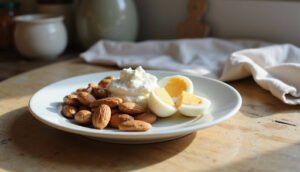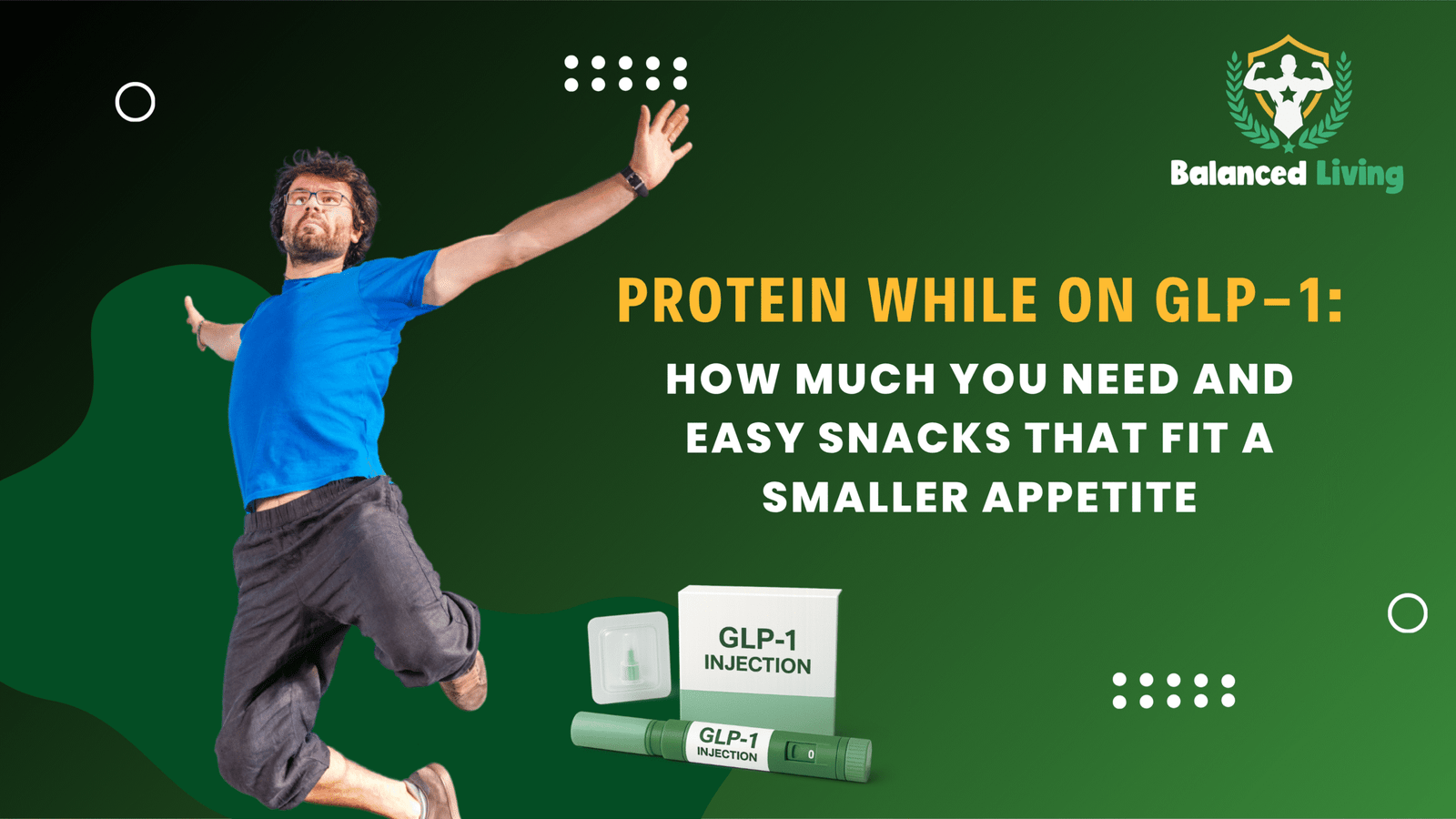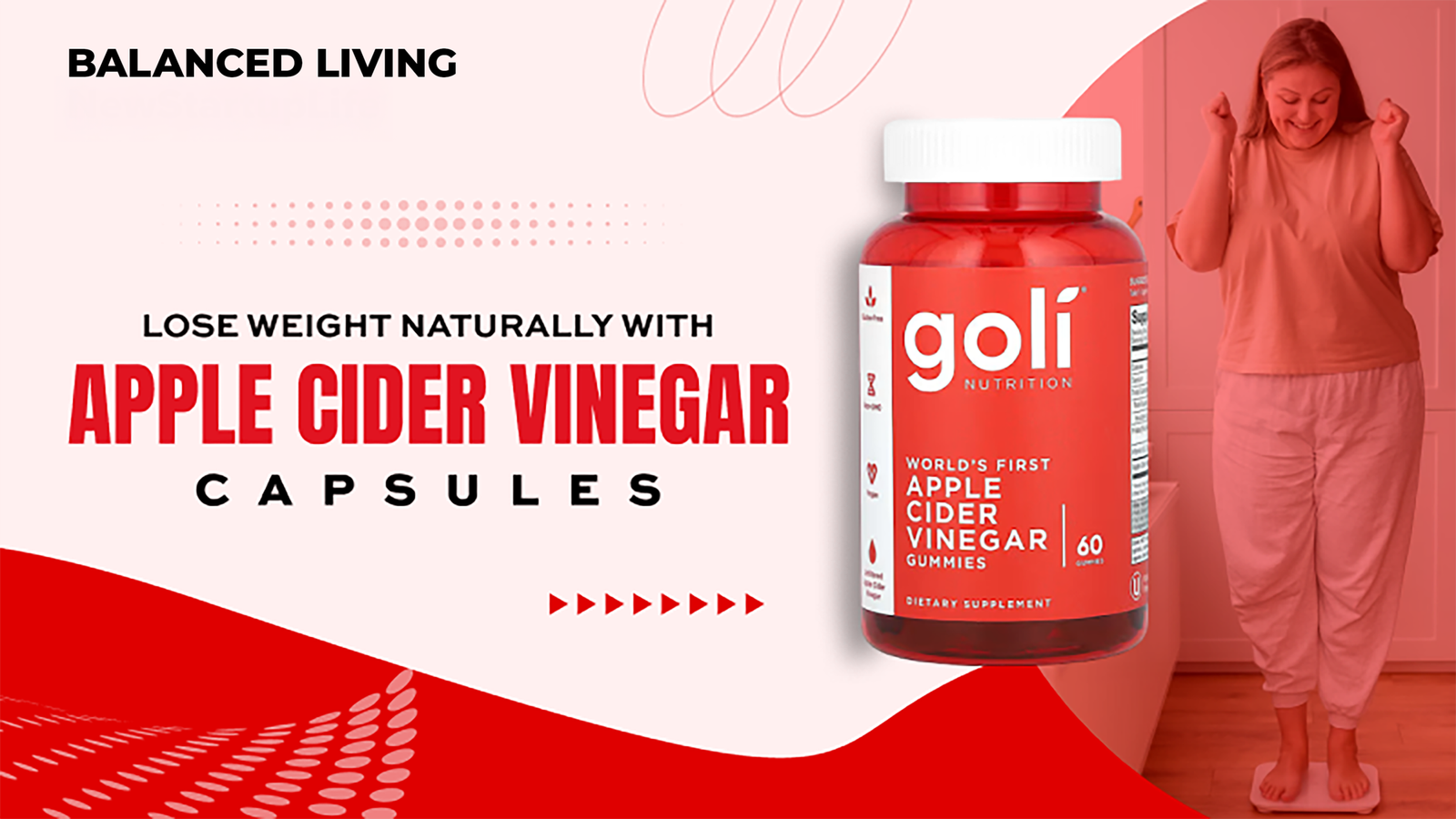
Getting enough protein while on semaglutide or Ozempic can feel tough. Smaller meals, queasy moments, and taste changes make it easy to miss your target. Most people need about 1.2 grams per kilogram of body weight to meet GLP-1 protein needs and protect muscle while losing weight.
This guide shows how much protein you likely need, why it matters for anyone on semaglutide or tirzepatide, and easy Protein Snacks For GLP-1 that fit a smaller appetite.
You will find simple, quick ideas that keep you fueled without feeling stuffed. If hunger is quiet these days, this is for you.
How Much Protein Do You Need While on GLP-1?
Most adults using GLP-1 medicines, like semaglutide or tirzepatide, need extra protein to protect muscle during fat loss. Your daily protein intake depends on age, activity, and how much food you can handle while on Wegovy or Ozempic. GLP-1 stands for glucagon-like peptide 1, a hormone that slows digestion and reduces appetite.
Recommended daily protein intake
Aim for about 1.2 grams of protein per kilogram of body weight while on GLP-1 medications like Wegovy, Ozempic, or Zepbound. That is roughly 0.55 grams per pound. If you weigh 150 pounds, set a floor of about 82 grams per day.
Make room on your plate for chicken, fish, tofu, or Greek yogurt. Cut back on low protein sides, like bread and sweets. GLP-1 therapy can reduce both fat and muscle as the scale drops, and some studies suggest up to 40 percent of weight lost can be lean mass. You want to defend that muscle with enough high-protein foods in a reduced-calorie diet.
As one registered dietitian might say:
Protein helps keep muscle strong even while losing weight fast on GLP-1s.
If eating enough feels hard, pick protein-dense snacks with all the essential amino acids, the building blocks of protein. Sliced rotisserie chicken beats cookies when only a few bites fit.
On light days, supplements like branched chain amino acids or omega-3 fatty acids may help until your next meal. Talk with a clinician if you have kidney disease or other conditions.
Factors affecting protein needs
Your ideal target shifts with your appetite, activity, and health history. Smaller meals on Ozempic or Wegovy can mean less protein at every sitting. That gap adds up.
The risk is real. Muscle loss can sneak in during rapid weight loss, and it is been seen with semaglutide or tirzepatide for obesity. Body composition scans can miss details since fat-free mass also includes water and minerals. Older adults face higher risk for sarcopenia, which means age-related muscle loss.
Activity matters. If you add walks or resistance training to protect muscle on GLP-1s, you will likely need a bit more protein and dietary fiber to stay regular and energized. Chronic conditions such as diabetes or kidney disease can change the plan. A registered dietitian-nutritionist who knows your history can help fine-tune your targets.
Listen to your body. Aim for steady energy, good strength, and a plan you can repeat on busy days.
Protein-Rich Snacks for Smaller Appetites
Protein can be hard to hit when even small portions feel big. These snacks are tiny, tasty, and mighty. Think of them as armor for your muscles.
Hard-boiled eggs
Hard-boiled eggs are simple and satisfying while taking GLP-1 medications like Ozempic and Wegovy. One egg has about 6 grams of complete protein, which means it has all the essential amino acids your body needs. That helps protect muscle with fewer calories.
They travel well. Keep a batch in the fridge for fast snacks. Make quick deviled eggs with mustard, slice over toast, or pair with veggie sticks for crunch. Many registered dietitians recommend eggs because they are nutrient dense and easy to digest on small appetites.
“A hard-boiled egg is nature’s original protein bar.”
Greek yogurt with berries
Greek yogurt delivers at least 10 grams of protein per serving and fits your GLP-1 routine. Top with berries for fiber and antioxidants. Fiber supports steady blood sugar and gut health, both helpful if constipation shows up on Ozempic or Wegovy.
This snack feels creamy but not heavy, so it works when your appetite is low. The mix of protein and soluble fiber helps you stay full between meals. Berries bring sweetness with fewer sugars than many desserts. If dairy is not your thing, skim ahead to the plant-based ideas.
Cottage cheese with sliced peaches is another fast option with similar benefits.
Cottage cheese with sliced fruit
Cottage cheese with fruit checks many boxes for anyone on GLP-1 medicines like Wegovy, Ozempic, or Zepbound. One small bowl usually offers at least 10 grams of protein. That supports muscle and reduces the risk of sarcopenia during weight loss.
Add berries or apple slices for fiber, vitamins, and extra hydration. This snack fits a balanced diet when your appetite is smaller. Low-fat versions keep calories in line. You get slow-digesting dairy proteins plus natural sugars from fruit for steady energy and better blood sugar control.
It takes minutes to make, no cooking required.
Tuna or chicken salad lettuce wraps
Ready for something savory? Tuna or chicken salad lettuce wraps work well when your food intake drops on GLP-1 meds. One wrap can deliver over 10 grams of protein. That is helpful when you want to prevent lean mass loss during weight loss.
Use canned tuna or shredded rotisserie chicken. Mix with diced celery and Greek yogurt. Add a pinch of smoked paprika or chopped cilantro for flavor. Spoon into crisp lettuce leaves instead of bread to cut calories and add hydration.
These wraps pack easily for work or school. No fork needed. The crunch makes them satisfying even with a small appetite.
Rotisserie chicken with veggie sticks
Rotisserie chicken breast is a fast, ready-to-eat protein you can grab from any grocery store. A three-ounce serving often gives at least 10 grams of protein with very little saturated fat. It is an easy way to meet your GLP-1 protein needs on Wegovy, Ozempic, Zepbound, or tirzepatide.
Pair with carrots, celery, or bell peppers for fiber and volume. That combo helps curb constipation and keeps you full longer. Rotisserie chicken is also less processed than many deli meats.
If you do better with frequent small meals because of nausea, this duo fits that rhythm. It is savory, simple, and kind to your schedule.
Plant-Based Protein Snack Options
Plant-based snacks can keep insulin steady and add variety while you are on GLP-1 medications. Soy products, nuts, and chickpeas offer protein with fiber and healthy fats.
Edamame
Edamame, young soybeans, pack solid protein for plant eaters and meat eaters alike. One cup has at least 10 grams of protein and plenty of fiber. That is a helpful combo if constipation shows up with Ozempic or Wegovy.
Steam frozen edamame in minutes and sprinkle with sea salt. Eat them hot or cold. They contain all essential amino acids, so they help protect muscle and lean mass while the scale moves down.
Use edamame as a side with veggie sticks, scoop them into guacamole, or toss over salad greens for texture.
Almonds and walnuts
Almonds and walnuts are easy to carry and keep fresh without a fridge. An ounce of almonds has about 6 grams of protein. That makes them a smart choice if you need more protein while on Wegovy or Ozempic.
Walnuts also supply omega-3 fatty acids, which support heart and brain health. Both nuts bring fiber that helps digestion and calms hunger between meals. Pair a small handful with fruit or sliced vegetables for a balanced snack.
Spicy crispy roasted chickpeas
Craving crunch with kick? Roasted chickpeas bring about 7 grams of protein per half cup, plus fiber. Toss with chili powder or smoked paprika for heat without many calories.
If you are vegetarian or vegan while managing muscle loss on GLP-1 drugs, chickpeas fit right in. They support fullness and regularity, helpful as your dose increases. Pack a bag for work or keep a jar in your pantry near other high-protein picks.
The shelf life is friendly to busy weeks. They also pair well with cottage cheese cups or yogurt for an extra bump in protein.
Peanut butter with apple slices
Peanut butter with apple slices is simple and satisfying. Two tablespoons give about 8 grams of protein. Apples add fiber and gentle sweetness that keeps blood sugar steady.
Dietitians often suggest this combo for GLP-1 users because it supports muscle without huge portions. Apples also bring water and vitamins, so each bite helps hydration too.
Slice an apple and dip into creamy or chunky peanut butter. It is quick fuel for errands or school pickups. If peanuts are off your list, try almond or sunflower seed butter.
No-bake oatmeal energy balls
Need something heartier? No-bake oatmeal energy balls are an easy make-ahead option when your appetite is small. Each ball can deliver at least 5 grams of protein from oats, nut butter, and seeds.
Oats provide soluble fiber that supports digestion. Nut butter adds healthy unsaturated fat and lasting energy. If you want more protein to prevent sarcopenia linked to semaglutide, stir in a little chocolate protein powder.
No baking needed. Mix, roll, and chill. They travel well and work for plant-forward eaters too. One or two between meals beats grabbing cookies or pastries when energy dips.
Convenient High-Protein Packaged Snacks
Some days you need grab-and-go. These options fit small appetites and help guard against muscle loss GLP-1 users worry about.
Protein bars
Protein bars can pack more than 10 grams of protein per serving, which supports lean mass and high protein weight loss. They live in your bag, desk, or car and help when traffic or meetings push meals back.
Choose bars with less sugar and lower saturated fat, ideally under 6 grams of added sugar. Many stores carry organic choices as well. For balance, eat half a bar with apple slices for extra fiber.
Popular flavors include cookie dough, churro, cocoa crunch, and semisweet chocolate chip. Handy after GLP-1 resistance training when you cannot get to a full meal. Scan labels so you do not end up with more sweetener than a donut.
Cheese cubes
Cheese cubes offer 6 to 7 grams of protein per serving and bring calcium too. They are easy to pack, easy to chew, and satisfy a savory craving during the afternoon slump.
Pair them with whole grain crackers or veggie sticks for fiber. You can find them at most grocery stores. If you tolerate dairy well, they are a convenient, minimally processed choice.
Protein shakes
If you want something smooth, protein shakes deliver 20 to 30 grams per serving. They help you hit your daily target when appetite is low on Wegovy or Ozempic.
Blend with USDA organic fruits or a spoon of nut butter for flavor and nutrients. A splash of almond extract can level up taste with no prep. Shakes work as small meals or snacks, especially after workouts to support muscle repair.
You can mix a powder with water or pick a shelf-stable bottle for busy days. Keep one in your work bag for backup.
Protein-packed brownies
Protein-packed brownies satisfy a sweet tooth while adding at least 10 grams of protein per serving. You can buy them or bake your own with whey, beans, or nut butter.
They make a smart dessert when Wegovy lowers your appetite and you still want something chocolate. Check labels if you track sugar or heart disease risk. For a simple upgrade, add berries on top for extra fiber and polyphenols.
Tips for Choosing the Right Protein Snacks
Smart snacks do more than fill a gap. Aim for protein, fiber, and simple ingredients so you get steady energy while using GLP-1 meds.
Look for snacks with at least 10 grams of protein
Picking snacks with 10 grams of protein or more helps protect muscle during weight loss. A carton of Greek yogurt, two hard-boiled eggs, or a cheese stick with hummus can meet that mark.
Protein-packed brownies or high-protein waffle mix can add variety without heavy portions. Be careful with processed snack packs that trade real nutrition for sugar, unhealthy fats, or additives. Those tend to backfire on energy and gut comfort.
Good choices include edamame, rotisserie chicken with veggie sticks, and cottage cheese with vitamin D fortified fruit. These give quality protein and fit busy days.
Pair protein with fiber-rich foods
Protein plus fiber keeps you full longer and supports regularity while on GLP-1 medications. Try hard-boiled eggs with sliced vegetables or chicken with leafy greens for crunch and hydration.
Fiber slows digestion and supports steady blood sugar. Oats, berries, whole grains, and lentils are easy wins. If food alone falls short, a psyllium supplement like Benefiber or Metamucil can help.
Combining cottage cheese with apple slices or Greek yogurt with berries adds nutrients and supports gut health. If you lift weights, these balanced snacks also support recovery so muscle loss is less likely as the scale moves.
Conclusion
Staying on track with protein while on Ozempic or Wegovy does not need to be complicated. Aim for about 1.2 grams per kilogram each day to protect muscle on GLP-1 and support steady progress.
Keep a short list of easy wins: Greek yogurt, cottage cheese with fruit, hard-boiled eggs, edamame, and roasted chickpeas. Packaged options like protein bars, cheese cubes, and ready-to-drink shakes help when life gets busy. Add vegetables for fiber and drink water so your gut stays happy.
Light exercise helps too. A couple of weekly strength sessions can lower the risk of muscle loss GLP-1 users face. If you have diabetes, kidney disease, or other chronic conditions, work with your clinician or a registered dietitian to personalize your plan.
Simple foods, small portions, steady protein. That is how you feel better, one snack at a time.
Frequently Asked Questions (FAQ)
If you’re on a GLP-1, keeping your muscle is key. Aim for at least 20 grams of protein per meal, especially if you’re doing resistance training or are overweight. This helps fight off lean mass loss and keeps your body strong.
When your stomach feels tiny, go simple. Try smoothies packed with Greek yogurt or cottage cheese; they slide down easy and pack a punch of protein without making you feel stuffed. Hard-boiled eggs, string cheese, or even roasted eggplant with cilantro can work too.
Vegetables are always smart picks, but some may ease tummy troubles better than others. If diarrhea strikes, stick to cooked veggies instead of raw ones; think soft carrots or zucchini over crunchy salads. For high blood pressure concerns, add potassium-rich options such as spinach into meals.
Absolutely! A dietetic professional can tailor advice just for you—especially if juggling issues like weight changes or tricky side effects from medication use gets overwhelming fast. They’ll help balance your plate so you get the most out of every bite without missing out on flavor or nutrition.















